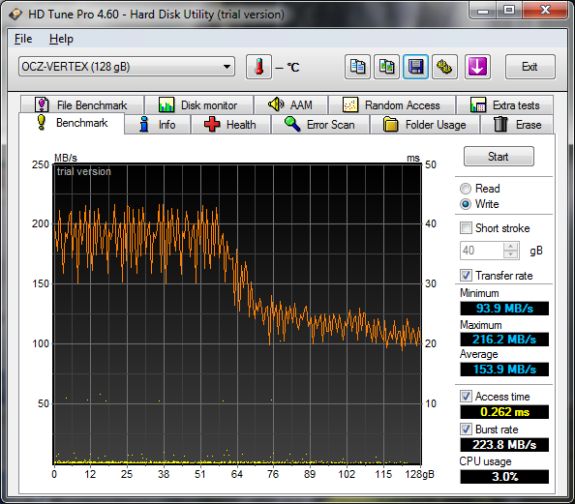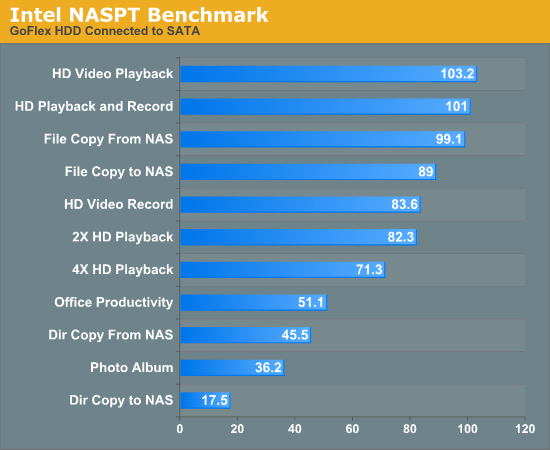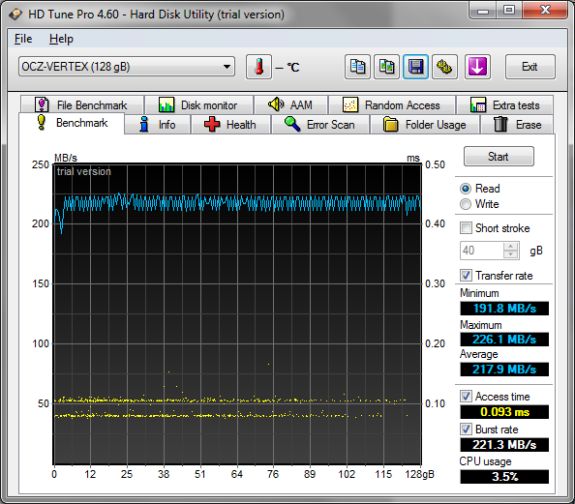Seagate GoFlex Home 2TB Reviewed
by Rajinder Gill on October 10, 2010 5:05 PM EST|
Testbed Setup Overclocking / Benchmark Testbed |
|
| Processor | Intel i5-750 CPU - 2.66GHz, 8MB L3 Cache |
| Motherboard | Biostar TPOWER I55 |
| OS Hard Drive | WD 250GB Caviar Black |
| Benchmark Drive | OCZ Vertex 120GB |
| Memory |
CorsairXMS3 CMX8GX3M4A1333C9 DDR3-1333 CAS 9-9-9-24 2GB |
| Video Cards | MSI 275 Lightning (stock clocks) |
| Optical Drives | Plextor PX-B900A, Toshiba SD-H802A |
| Case | LIan Li V-2110 |
| Operating System | Windows 7 64 bit |
| . | |
Our test system consists of Biostar’s TPOWER I55 motherboard, teamed up with an Intel i5-750 Lynnfield processor. We utilized Intel’s NASPTexerciser to benchmark the Go-Flex Home. Windows 7 Ultimate provided the foundation for our test, although we used 2GB of memory as per Intel recommendations to ensure benchmark accuracy (preventing caching of data). A 250GB WD Caviar Black HDD is used for our OS installation, while the NASPT benchmark is run from the OCZ Vertex SSD. We include screenshots of the Vertex's read and write performance below:

OCZ Vertex 120GB Read and Write Performance.
Our test system should have more than enough bandwidth to highlight potential bottlenecks at the GoFlex end of the line. The network drive is attached directly to the test client machine via the onboard Intel 82578 NIC.
NASPT Benchmark
The NASPT exerciser generates traffic at the file system level using typical user application semantics. The traffic generated emulates actual traces of real applications’ file system requests. We ran the entire benchmark test three times, closing the test suite between runs and opening other software - again, this was done to ensure caching did not skew results.

The read based tests seem to fare pretty well, anything involving write operations though, seems to end up sub-par. To confirm a controller/drive level problem we removed the GoFlex from its docking station and attached the drive directly to a SATA port on the test client machine:

File copy times over the SATA bus see a huge boost over the ethernet~docking station combo. The write bottleneck appears to be a facet of the controller -why the problem exists we're not sure, it obvously means that large file transfers over a network could end up taking painfully long on the GoFlex.
Temperatures
Unfortunately, Seagtate’s bundled software does not include provision for temperature monitoring. Third party SMART monitoring software won’t pick up the drive’s vital statistics via Ethernet ports either. The only way we could get an indication of temperatures was to remove the drive section and plug it into a motherboard via SATA instead. This proved to be a bit of a challenge as the SATA connector is recessed to the extent where we needed to shave the end connector on the cable down for it to fit through the slot in the casing. Here's what we ended up with after a couple of hours of continuous use in an ambient room temperature of 17 Celsius:
| GoFlex 2TB Temperature | |||||
| Idle | Load | ||||
| 34C | 43C | ||||
The end result here is nowhere near as bad as what Anand got from the 3TB unit, although we should be mindful of the fact that we’ve taken the base unit out of the equation here. At a guess the base unit will add another 5~10 Celsius to the temps, bringing us into the fifty Celsius region during sustained use - it's acceptable.
Power Consumption
| GoFlex 2TB Power Consumption | |||||
| Idle | Load | ||||
| 4W | 10W | ||||
We measured power AC consumption of the GoFlex unit at the mains. The GoFlex goes into Idle mode after abour 30 minutes of inactivity, at which point the power consumption will drop to around 4W. A "full load" power draw of 10W is fine for a network drive of this size.
Final Words
If you're looking for a plug-and-play NAS drive, the 2TB GoFlex certainly has its appeal. Unlike the 3TB USB drive that Anand reviewed last month though, Seagate aren’t the only players in the segment as there are other 2TB network drive options out there at a similar price ($200~$230). Most of the paper specs are largely similar, leaving things down to certain aspects of performance, bundled software, user interface flexibility and upgradeability.
The GoFlex Home manages to tick most of the software and ease of use boxes, and even has a window of opportunity for drive replacements and "upgrades" (if one outgrows 2TB of storage). The caveat with the replacements/upgradability being that you're tied to using a GoFlex unit due to the propietary mating mechanism of the drive and base unit. That being said, standalone single drive units like these from other vendors aren't known for offering such options at all, so Seagate manage to do enough to obtain a small lead even though it's not perfect.
This time round, we're pleased that we don't have to issue a word of caution about operating temperatures like we did on the 3TB GoFlex Desk. The 2TB GoFlex Home seems to operate within the bounds of what we'd deem safe without impacting drive longevity.
Our only major gripe with the GoFlex Home pertain to the rather slow write performance; it's a fraction of the read speed. If you're buying 2TB of network storage you're likely to have a serious amount of data to shift over to the drive at some point - it's not a pleasant experience on the GoFlex. We also think that the 2TB version of the drive should offer the ability to create an unlimited number of user accounts as standard rather than asking users to fork out a $19.99 per annum subscription for the privelage.
Unfortuantely, we have yet to test similar sized NAS drives from other vendors so can't say for certain if or how far the GoFlex's write performance lags behind the competition - we're trying to get more samples in so that we can make a more informed conclusion. For now, we'll finish off by saying that if you can put up with the slow write performance (or if time is not of the essence), the GoFlex Home has plenty going for it as an easy-to-use network drive that will get the job done.











30 Comments
View All Comments
brucek2 - Sunday, October 10, 2010 - link
They mention later on that there's a GigEthernet port as well.Voldenuit - Monday, October 11, 2010 - link
WTF. Seriously?A NAS that uses a proprietary drive mounting system, charges a subscription fee to give you unlimited account access and is crippled by writes?
You could/should have completed the review with just two words: 'IT's CRAP' and tossed the damn thing into a trashcan.
I imagine something like a Synology NAS would have this thing licked in terms of features, performance and upgradability (hont: would love to see a proper review of a Synology NAS to compare). Recommending the GoFlex for *any* user (especially what amounts to uninformed general users) with little or no comparison to the rest of the market seems irresponsible to me.
Voldenuit - Monday, October 11, 2010 - link
*hint, not hont.dia - Monday, October 11, 2010 - link
If it were as bad as you imply, Small Network Builder would have arrived at a different conclusion, too. I think given the type of user this drive is aimed at it's not bad overall.http://www.smallnetbuilder.com/nas/nas-reviews/312...
HMTK - Monday, October 11, 2010 - link
You can't compare this to a Synology on features nor price.Voldenuit - Monday, October 11, 2010 - link
A Synology DS210 is $200 (bare unit) and has 2 drive bays, DLNA, RAID and bittorent functionality. The type of user who needs a NAS will probably have spare hard drives lying around and/or would appreciate not being locked into a vendor-specific configuration. Anyone who puts a 2 TB drive in a NAS probably won't appreciate slow write speeds, either.If the Synology performs to expectations (hint: review pls), it would represent much better value and be a better technical solution than the Seagate.
PS Did AT test performance under multi-client access? After all, the point of a NAS is to serve multiple users on a single network.
Duftopia - Sunday, September 14, 2014 - link
I would have agreed with you when I bought the unit. Seagate on the other hand does make A++ Hard drives which is what they are good at, they DO NOT write A++ software, nor have exceptional support (as of 2013).the $9.99 subscription was in my opinion a travesty, NO professional company like Seagate should resort to such a money grab, but after several years of use I must say the drive is an exceptional and cheap backup and streaming device (although almost always behaves as-if its on its last leg).
Duf
baba264 - Tuesday, October 12, 2010 - link
I'd be quite interested by reading reviews of other NAS units as I might be interested in buying one in the not so distant future (6 month or so).I would be interested to see what higher priced solutions have to offer and would particularly like to read about solutions that would allow RAID 5. As was said before, with these kind of solutions, it is nice to have some kind of insurance against drive failure.
Rajinder Gill - Tuesday, October 12, 2010 - link
Hi,We'll try and get some more stuff in to review - specifically enclosures offering redundancy. This is our first NAS review so there's room for improvement and we're taking all suggestions into consideration for future articles.
-Raja
Voldenuit - Tuesday, October 12, 2010 - link
Thanks Raja!Looking forward to more reviews from AT on NASes as they become more relevant to home users. Maybe even find some way to put them on Bench? ^_~ Things that I can think of offhand that would be good to know before spending $200+ on a NAS:
1. Performance under different connection protocols (100/1000/801.11n)
2. Read and write (and concurrent r+w) speeds
3. Performance scaling with multiple queues/users
4. Setup and installation
5. Compatibility with various client OSes and HDDs (Advanced format, 2 TB+ etc)
6. Administrative access
7. Features and utilities (usb printer server, http/ftp host, BT, RAID, QoS)
8. Streaming features and compatibility (xbmc, DLNA, Boxee etc etc)
9. Power, heat and noise (some NASes have tiny whirring fans, others resonate HDD noise)
You covered quite a few of these in your review, obviously the GoFlex is a very basic device compared to its peers in terms of features.
It might be interesting to set up a baseline system to compare NAS performance with a cheap DIY server like a miniITX Atom server running Linux/Windows. Especially when Bobcat trickles in.
I'm sure more suggestions will trickle in, so let me say thank you again for taking on this monumental task ;).